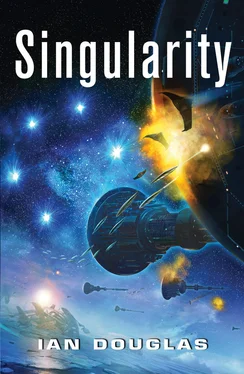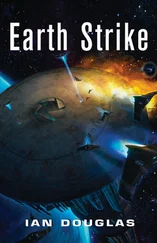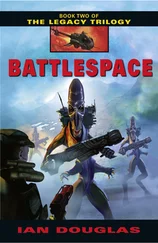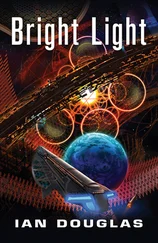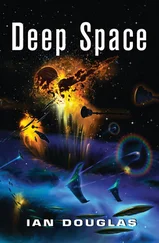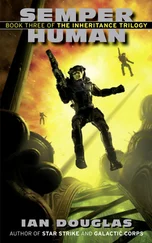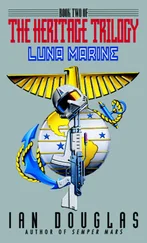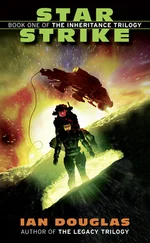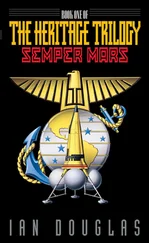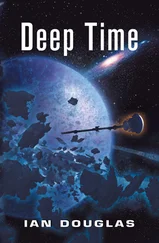1 ...8 9 10 12 13 14 ...22 The Valley Forge was pivoting slightly now, bringing her main battery, a spinal-mount CPG, to bear. A moment later, she fired—a burst of tightly focused high-energy-charged particles invisible to the unaided eye but showing clearly on Gray’s instruments and on his visual display. The beam burned past the shield cap of the Jeanne d’Arc , missing the carrier by less than a hundred meters.
“ Jeanne d’Arc ,” Koenig’s voice said over the fleet channel. “That was a warning. Change course immediately, or we will take you under fire.”
“You’re not going to fire on Confederation vessels,” Giraurd’s voice came back. “Surrender and save your people, and your reputation.”
“Dragonfires!” Wizewski’s voice snapped. “You are weapons free. Go! ”
“That’s it, Dragons!” Gray called. “Maximum acceleration in three … two … one … now !”
Twelve Starhawk fighters leaped past the challenge line, hurtling toward the oncoming Pan-European warships. The range was just under 480,000 kilometers. At fifty thousand gravities they closed the gap in just forty seconds.
A typical strike fighter mission had the fighters zorching through an enemy formation at high velocity after a long period of acceleration. This was different, however, with only a relatively short distance for acceleration before the fighters reached the target. The squadron’s newbies hadn’t practiced this sort of tight, close-quarters maneuvering in training sims, and they were going to be making mistakes.
Gray just hoped none of those mistakes would be fatal.
“Jink!” he yelled over the tactical channel. “All Dragonfires, jink !”
By throwing drive singularities to left, right, above, and below at random, they could jerk their fighters around enough to fox enemy targeting AIs as they continued to close the range.
On the tactical display, the Pan-European fighters had leaped forward, seeking to head the Starhawks off.
“Ignore the fighters,” Gray told the squadron. “Stay on the carrier!”
“They’re firing! Missiles incoming!”
Missiles streaked out from the incoming fighters, curving to meet the fast-moving Starhawks.
“Don’t let it rattle you,” Gray said, suppressing the trembling surge of fear he was feeling. “Stay on course. Stay on the carrier. …”
White light flared, dazzling and silent in the darkness. The Dragonfires flashed through expanding clouds of plasma, emerging … and then the two clouds of fighters interpenetrated, passing through each other in an instant.
The Jeanne d’Arc and her consorts lay just ahead. …
CIC
TC/PE CVS Jeanne d’Arc
Kuiper Belt, HD 157950
98 light years from Earth
1748 hours, TFT
“Harrison has betrayed us,” Hans Westerwelle said, bitterly. “He warned Koenig, somehow.”
“We don’t know that,” Giraurd replied. “I … agree that he was less than eager to open the dialogue with Koenig.”
“‘Less than eager’? The Englander swine fought the idea tooth and nail. Koenig was his friend. We should investigate Harrison when this is over, and see where his true loyalties lie.”
The plan to have the three British ships pretend to join Koenig’s squadron had been Westerwelle’s. He was the European fleet’s political officer, a civilian appointed by Geneva to maintain loyalty and an acceptable level of enthusiasm within the Federation’s ranks.
The first nuclear-tipped missiles were detonating in brilliant, savage silence across the CIC’s forward view screens. They were unlikely to cause more than superficial damage to the incoming fighters, but they might deter, might force the enemy squadron commander to break off.
“Enemy fighters are still approaching from dead ahead!” the tactical officer called. “They’re at seventy percent of c and accelerating!”
“Engage point defense!” the Jeanne d’Arc ’s captain ordered. “Fight them off!”
Giraurd sat back in his command chair, watching the CIC and bridge crews carry out their routines. It had been months since the Jeanne d’Arc had been in combat, and many in her crew were new to the ship, having come aboard just before the flotilla had left for Alphekka. It would be interesting to see how well they did in this, their first exercise that was not a drill. Her captain, Charles Michel, had seen action during the Defense of Earth, but he was Belgian rather than French, and Giraurd wasn’t sure he trusted the man.
Unfortunately, there were a lot of officers on board he didn’t entirely trust. Sawicki, the tactical officer, was a Pole. Mytnyk, the fighter wing commander, was Ukrainian, while the political officer, Westerwelle, was a German. And then there were the British, always a problem in European Federation politics.
The Pan-European Federation had been a superb idea on paper, but even now, more than 270 years after the Pax Confeoderata and more than 400 years after the Treaty of Maastricht, the idea of a union of European states sounded better than it worked. The Terran Confederation, it was said, was only as strong as its weakest members, and for all their public bravado, the Pan-Europeans rarely were able to show a solid or united front.
Of course, the North Americans had the same trouble—descendents of the old United States trying to show a common front with Canadians, Mexicans, and a clutter of tiny Central American states. Political unions simply didn’t work when the member states had more differences than similarities.
The odd thing about the situation was that threats from outside generally forced such unions to put aside internal differences and pull together; but if anything, the war with the Sh’daar had reawakened old animosities, infighting, and name-calling. The ancient cracks in the painted façade were showing, not only within the European Federation, but all throughout the realm of Humankind.
What was needed was a stronger government, a government with the resolve to force the disparate fragments of humanity into line. Politically, Giraurd was a Federationialist, a neosocialist political party calling for the final abolition of the old nationalist states and the creation of a genuine United Terra.
And that day was coming. Humankind had no choice but to unite in the face of the threat from outside. The first step was to crush the so-called independence movements in the USNA, and that meant bringing mavericks like Alexander Koenig into line. A united Humankind couldn’t afford individualists like Koenig or the right-wing political reactionaries remaining within the USNA’s government.
And so, in a way, the unification of mankind began here. “Hit them with everything we have, Mr. Sawicki,” he said.
Nuclear fire continued blossoming in stark and dazzling silence against the forward view screens.
VFA-44
Kuiper Belt, HD 157950
98 light years from Earth
1749 hours, TFT
A European Federation Raschadler flashed past on Gray’s port side, a thousand kilometers distant, practically at point-blank range, though too distant and far too fast relative to him for him to pick it up optically. Their name meant “Swift Eagle,” but in space combat, it was how many gravities a drive could pull that counted, not the actual velocity. Where the USNA Starhawks could pull up to fifty thousand gravities—an incredible performance—the Raschadlers could manage only about two thousand Gs. Where Starhawks could be pushing the speed of light after ten minutes of acceleration, it took the older Swift Eagles over four hours to reach near- c .
Читать дальше
